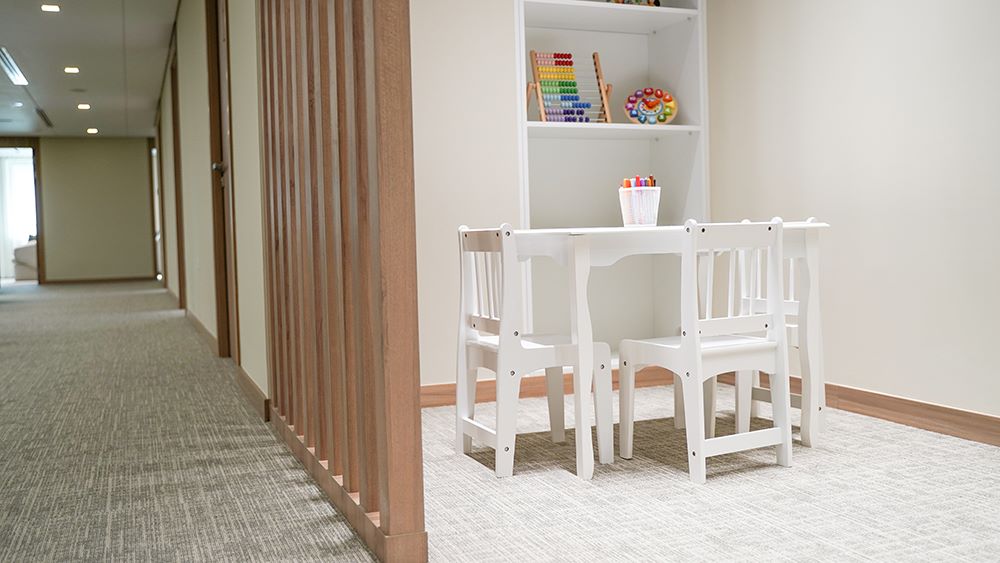Navigating worry in young children
By Dr Charlotte Cousins, Clinical Psychologist, Lead of Children & Adolescent Services and Perinatal & Couples Specialist
Childhood worries are not just normal; they signify a healthy imagination and brain development. Learn how to support and empower your child in managing their worries with five expert tips.

Why do children worry?
Worrying in young children is a very common and a normal part of child development. In fact, worry is a sign of a healthy imagination and developing brain.
Children’s minds are sponges, absorbing, and trying to make sense of all the information they are exposed to every day. As children process this information their imagination can take them to some very weird and wonderful places, not all of which can be helpful, and some may even be scary.
Is it just a phase?
You might be wondering whether, or really hoping, that this is just a phase. For many children it will be a phase and something they simply ‘grow out of’ or learn how to manage. However, for some children the worry will stick around, and they may need some professional support to learn how best to manage their worry. I will provide information on when to seek professional support and the services we offer here at Sage.
How can I support my child with their worries?
Top five tips
- Listen to their worries.
A lot of people think that listening to their child’s worries gives life to them and makes the worry worse. As a result, they say things like ‘don’t be silly’ or ‘there’s nothing to worry about’. This can result in the child thinking that they are silly, that they shouldn’t feel this way and that there is something wrong with them. This means that they are less likely to share their worries and seek support from an adult for problems in the future. The reality is that the worries are present for your child whether we talk about them or not. We need to show the child that we are here to listen and help them learn how to respond to their worry.
- Acknowledge their feelings.
Whilst listening to their worries, name and acknowledge the feelings your child is experiencing. This helps them learn to identify and name their feelings for themselves. If you aren’t sure, that’s ok, give it your best guess. This might look like:
‘Thank you for sharing that worry with me, I can see that the darkness in your bedroom at night is making you feel really scared’.
‘I can see that this worry about your friend not inviting you to their party is making you feel really anxious’.
‘I can see that this worry is really affecting you, is it making you feel sad?’

- Externalise the worry.
Externalising the worry means locating the worry outside your child. Keep reading for examples of how to do this. Locating the worry outside of your child helps them to learn that the worry is something that they experience but it is not them. The worry is the problem, they are not the problem. This helps them feel more able to tackle the worry, as they don’t see it as an intrinsic part of themselves.
Get creative with the approach you take to externalizing. Get your child involved and ask them to use their imagination. Ask them to describe the worry – is it an animal? A person? A character from a film? What qualities does it possess?
Here are some examples of ways of externalizing:
- The worry monster – comes in uninvited and stomps all over my brain.
- Steve the worry snake – silently slithers into my thoughts.
- Walter the angry wolf – howls so loudly that I can’t hear myself think.
- Get to know the worry!
Once you have externalized the worry and found a way of referring to it that feels like a good fit for your child, ask your child some questions to help you better understand the worry. You want to find out what makes the worry appear, what makes it worse and what makes it better? This will help you identify how best to respond to the worry. Don’t be afraid to be silly and playful with this approach, this can really help to lighten the mood and reduce the level of fear for your child.
Here are some examples of questions you can ask your child:
- What makes the worry monster appear?
- What makes Walter the angry wolf howl so loudly?
- Does anything quieten him down and stop him howling so loudly?
- When does Steve the snake tend to appear?
- Have there been any times that you have been able to make Steve slither away again?
- When getting to know the worry we are looking for ‘exceptions to the rule’ i.e., the times that our child has been able to overcome the worry and how they were able to do this.
- Team up against the worry
Once you have got to know the worry team up with your child and help them ‘fight’ against the worry. Again, get creative, draw upon their imagination and use phrases such as ‘I am going to be your side kick in our quest to quieten down Walter the wolf’ or ‘let’s become worry warriors and battle against the worry monster together’.
Draw upon the information you gathered in the last step, focus on what causes the worry and what makes it worse? Is there anything you can put in place to prevent this?
What helps? Is there anything that keeps the worry at bay or helps the worry go away once it has appeared? How can you build upon this?
Again, don’t be afraid to get creative and use the power of your child’s imagination. We know that when the child comes up with the idea or approaches themselves it is much more likely to be effective.

Here are some examples:
- An invisible cloak that acts as a repellent to the worry monster. For children that worry a lot at night, you can include putting on the cloak as part of the process of getting ready for bed.
- Drawing a heart on your child’s hand and your hand, holding them together to fill them both up with love so that your child can still feel your love when you are apart. This works particularly well for children that feel worried when they are away from a parent. This can help them connect with the feelings being close to their parents provides such as love and comfort, even when they are away from the parent.
- Get your child to imagine picking up a remote control, pointing it at Walter the Wolf and turning down the volume of his howl.
When should I seek additional support for my child’s worries?
If you are noticing that your child has been worrying consistently for a prolonged period of time, that the worries are having a significant impact on multiple areas of their life such as at home, with friends and at school and are causing them considerable distress they may benefit from psychological therapy. Here at Sage Clinics, we have a range of highly skilled child and adolescent psychologists that offer evidence-based psychological therapy for children and their families.
For more information, call +9714 575 5684 or email appointments@sage-clinics.com











Comments